2015 Toyota TRD Pro Models Cont.
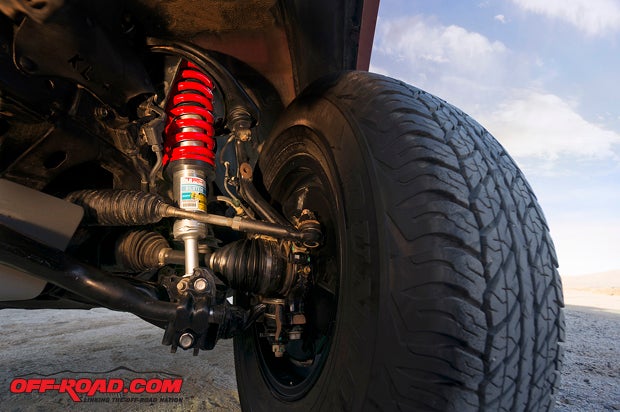
When it comes to capability, the 17-inch black TRD wheels are fitted with more aggressive 31.5-inch all-terrain Nitto Terra Grappler tires. For added trail protection, an aluminum skid plate offers engine bay protection at the front of the vehicle, while the TRD Pro model still retains the fuel tank and transfer case skid plates. For suspension, the 4Runner is fitted with Bilstein 5100 monotube shocks, with the front featuring a 2.5-inch Bilstein shock with a 60mm piston and the rear a larger 2.0-inch Bilstein shock with a 46mm shock piston, which is a marked improvement over the 32mm OE piston found front and rear of the stock 4Runner. The larger shock diameter improves suspension ride quality and durability while also offering more volume for additional shock fluid to keep the shocks cooler during prolonged off-road use. The TRD-tuned Eibach springs are designed to improve ride qualify on road and off, and the new springs provide an additional inch of ride height over stock. The new shocks have also been reworked for an additional 1 inch of down travel for increased off-road articulation.
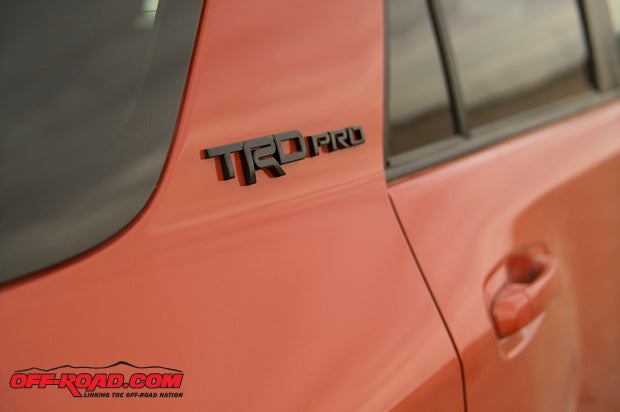
The TRD Pro 4Runner will retain the factory rear coil springs, stabilizer bar, end links and bump stops. The 4Runner TRD Pro will also retain the 4Runner’s Multi-Terain Select (MTS) and CRAWL Control features to dial in the vehicle’s performance to match the terrain conditions.
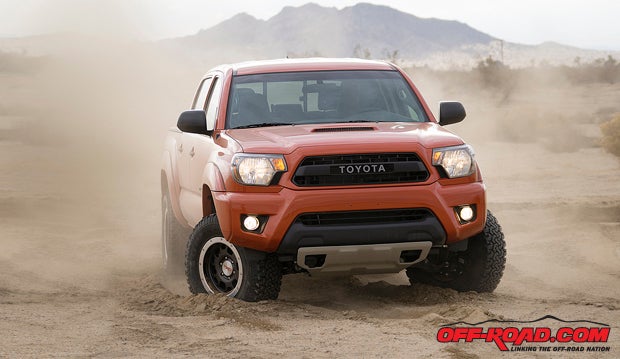
TRD Pro Tacoma
Just like the 4Runner takes cues from the Trail model, the Tacoma TRD Pro gets its inspiration from the TRD TIX Baja Series Package. The TRD Pro version will be available in both an Access Cab and Double Cab, and though the 4.0-liter V6 is the only engine option buyers can select either an automatic or manual transmission for the Tacoma.
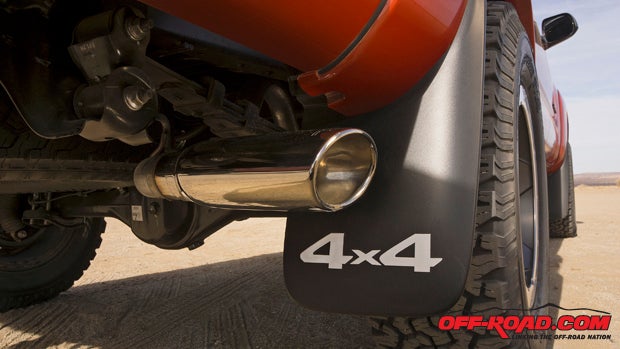
The TRD Pro Tacoma offers a number of unique styling cues on the exterior, including the unique TRD Pro black grille, black Tacoma door badging and a TRD Pro badge on the tailgate, while inside TRD floor mats and a TRD shift knob give the truck some added flair.
The TRD team fitted the Tacoma with 16-inch bead-lock-style TRD alloy wheels, which feature a +10mm offset to give the truck a slightly wider stance. The wheels themselves tip the scales at only 23.5 pounds, so not only are the wheels smaller than stock (a key benefit off the highway), but they also are lighter. BFGoodrich All-Terrain T/A KO tires provide great grip off the pavement and on the road.
For suspension, the TRD Pro Tacoma is outfitted with 2.5-inch Bilstein 5100 coilover shocks with TRD-tuned Eibach springs. Much like the Tundra, the Tacoma’s front suspension setup provides a ride height increase of 2 inches to level the front of the truck and provide improved ground clearance. The shocks themselves feature larger, more rigid 18mm shafts (OE are 12mm) that add strength and durability, and they are engineered to provide an additional inch of movement for additional wheel travel. The larger shocks also feature 60mm digressive Bilstein pistons that are almost twice the side of the 32mm stock shocks and still significantly larger than the TRD Off-Road rear shocks (36mm).
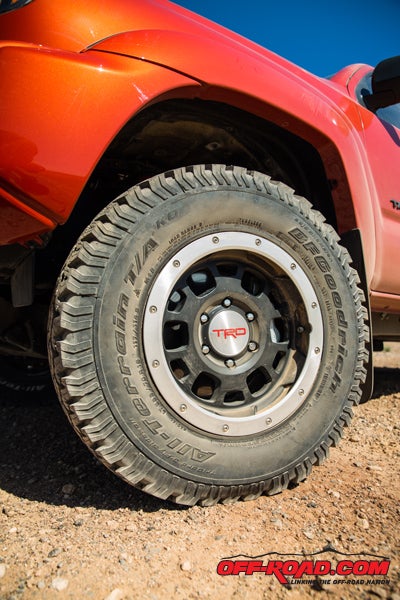
Out back, the TRD team fitted 2.0-inch Bilstein 5100 shocks with remote-mounted reservoirs. Though they are smaller than the 2.5-inch shock up front, Toyota says they are designed to be comparable to a 2.5-inch shock but stuffed into a smaller package. The rear shocks use a larger 46mm piston that is more than 50 percent larger compared to stock (30mm) and still much larger than the TRD Off-Road pistons (36mm). The rear shocks are designed to offer 1.5 inches of increased down travel for increased articulation off-road, as the upgrade rear shocks work with the factory leaf springs to soak up the bumps.
Capping off the features on the TRD Pro Tacoma is a cat-back TRD performance exhaust system. While adding a more aggressive pitch to the 4.0-liter V6 engine is one part of the sell, the TRD exhaust is also designed to boost performance, adding between 5-8 horsepower overall and increasing the low-end and midrange torque all while retaining a pitch under the legal 95-decibel noise limit. The 304 stainless-steel free-flow exhaust is finished off with a TRD logo on the tip of the pipe exit.
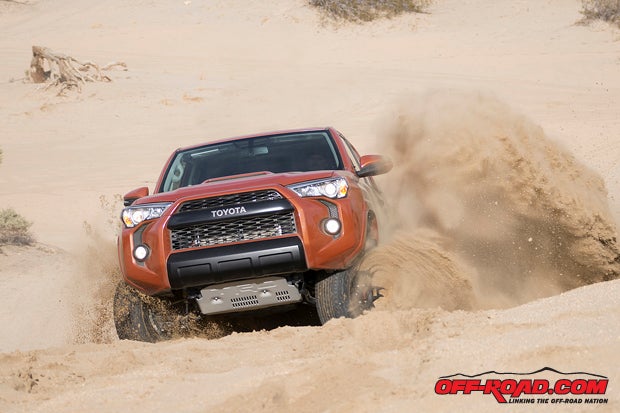
Ride Impressions
Toyota invited us out to Las Vegas to check out the new line of TRD Pro vehicles for 2015, and after a technical presentation and a walk around for each vehicle, we were ready to check them out. We jumped in the TRD Pro Tundra first, and we were pleasantly surprised to immediately notice the higher stance of the Tundra. A twist of the key in the ignition fired the 5.7-liter engine to life, and a more aggressive rumble was notable coming from the TRD dual exhaust.
As we jumped onto the 15 freeway and made our way south of Vegas to Goodsprings, we were impressed with the aggressive, yet not high-pitched, rumble from the TRD exhaust. The handling of the truck was great on road as well, as the higher stance of the truck felt great and the suspension didn’t feel floaty or loose in turns – it retained a stock-like feel actually.
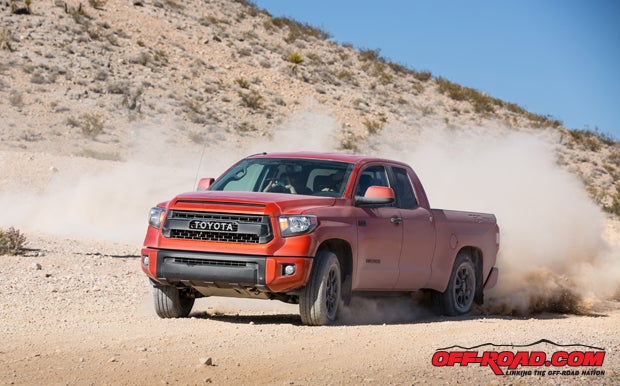
While the Tundra felt just fine on the pavement, getting it onto the dirt is where it really started to shine. Traveling with a number of other TRD Pro Tundras, we were led through some pretty torn-up Nevada desert trails, which were full of rocks, ruts, whoops and dips. The additional 2 inches of clearance and travel up front is notable in the bumps, as driving the truck through whooped-out sections at 20-25 mph caused no bottoming out of the suspension or frame contact with the ground. Toyota only dropped the tire pressure down to 30 psi, which was at least 10 to 12 psi higher than we would have liked, but it also provided us a real chance to feel just how well the Bilstein shocks soaked up the rocks and ruts – quite well in our book! If we have one gripe on the Tundra it’s the lack of locking rear differential on the truck, which is something that’s found on the Tacoma. Yes, there’s an automatic limited-slip differential, but it’s just no replacement for a true diff lock.
Hopping in the 4Runner and the higher stance is immediately apparent as well, though its taller stance didn’t provide soft or wobbly cornering. Once we hit the dirt, the 4Runner’s additional front-end clearance made crawling up and down hills a more confident endeavor. Our more Jeep-style off-road course featured a number of whoop sections, where the shocks were constantly working to cushion the swaying vehicle, though we never noticed any fade in performance thanks to the larger-oil-capacity Bilstein shocks.
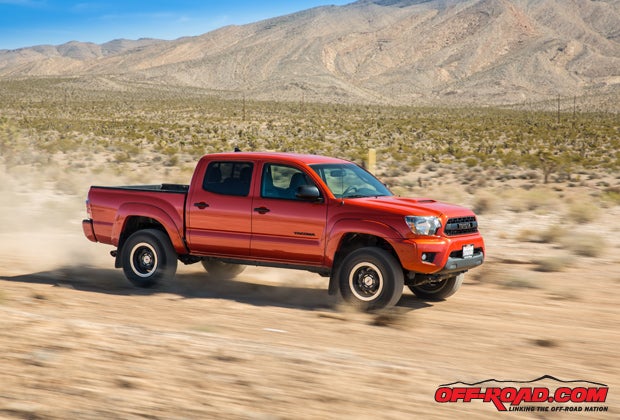
Although the Tacoma features an additional 2 inches of ground clearance up front, upgraded shocks and the most aggressive tires in the bunch in the BFGoodrich A/T KO, we thought it might be the most fun to drive in the dirt – but it didn’t live up to our expectations. Although we turned off the stability control in the Tacoma, when trying to break the rear end loose in dirt corners the Tacoma would start to break free and – BAM – the stability control would yank the truck back in. For a driver who’s looking to get the rear end a little loose and knows how the vehicle will respond, the quick yank from the stability control is quite startling and felt intrusive. After speaking with Toyota engineers, they explained to us the stability control never fully turns off on the vehicles, though we will say we were able to break the back end loose on the Tundra and did not experience any input from the stability control in similar situations – so maybe the Tacoma’s is a little more sensitive.
Stability-control gripes aside, we enjoyed the overall ride of the Tacoma. The straight-line stability of the truck is great on quicker sections of fire roads, it handles rocks and whoops with confidence and control, and the added ground clearance up front makes approaching rocky washes less nerve-racking since there’s less concern of hanging the front end on a rock. The upgrades simply feel less drastic on the Tacoma than on the rest of the bunch, which may partially be due to the fact that the current Tacoma lifecycle is coming to an end soon, and Toyota and TRD may have focused more effort on the other two packages knowing a new Tacoma is just around the corner. We enjoyed the truck and like the package, but the Tundra and the 4Runner felt so great that the Tacoma was simply a small let down.
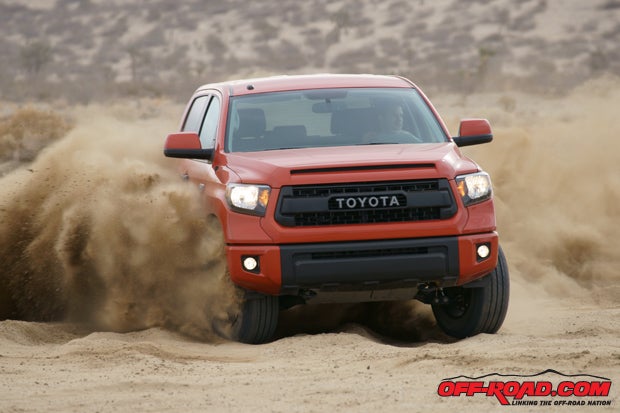
It’s a Wrap
The 2015 TRD Pros were designed to push Toyota’s off-road options to another level, and we feel safe to say mission accomplished. The appearance of each vehicle certainly makes them stand out from the crowd as well, with the Inferno color option being the most eye-catching, though many will appreciate the subtle unique styling cues on even the white and black versions.
Although each vehicle is a clear-cut upgrade over stock and even its comparable TRD model (or in the 4Runner’s case, Trail version), the Tundra is the showstopper in our opinion. The TRD Pro Tundra offers impressive off-road performance, a great on-road feel, and it offers enough blend of customization and performance parts to truly make it a worthwhile package. While Ford Raptor comparisons will logically be drawn to the TRD Pro, we’re not sure they should be. The Raptor can be pushed closer to a near-race-truck level, whereas the TRD Pro is really more a well-rounded off-road package for the enthusiast. Maybe the distinction between the two consumers isn’t a wide gap, and it’s realistic that this truck buyer would look at both vehicles. Yet we never got the sense Toyota was looking to “one up” Ford with its TRD Pro; instead, they looked to push themselves to produce an even better off-road package than the one already offered. With prices still unreleased from Toyota for the 2015 TRD Pros, maybe the final decision will come down to cost. If we had to choose, our money’s going down on the 2015 TRD Pro Tundra, though every TRD Pro vehicle is at least worthy of consideration.


 Your Privacy Choices
Your Privacy Choices